11.1 HEALTH professional Students
The University of California educates and trains more than 16,000 health care professionals annually.
11.1.1 Health professional students by discipline, fall 2024
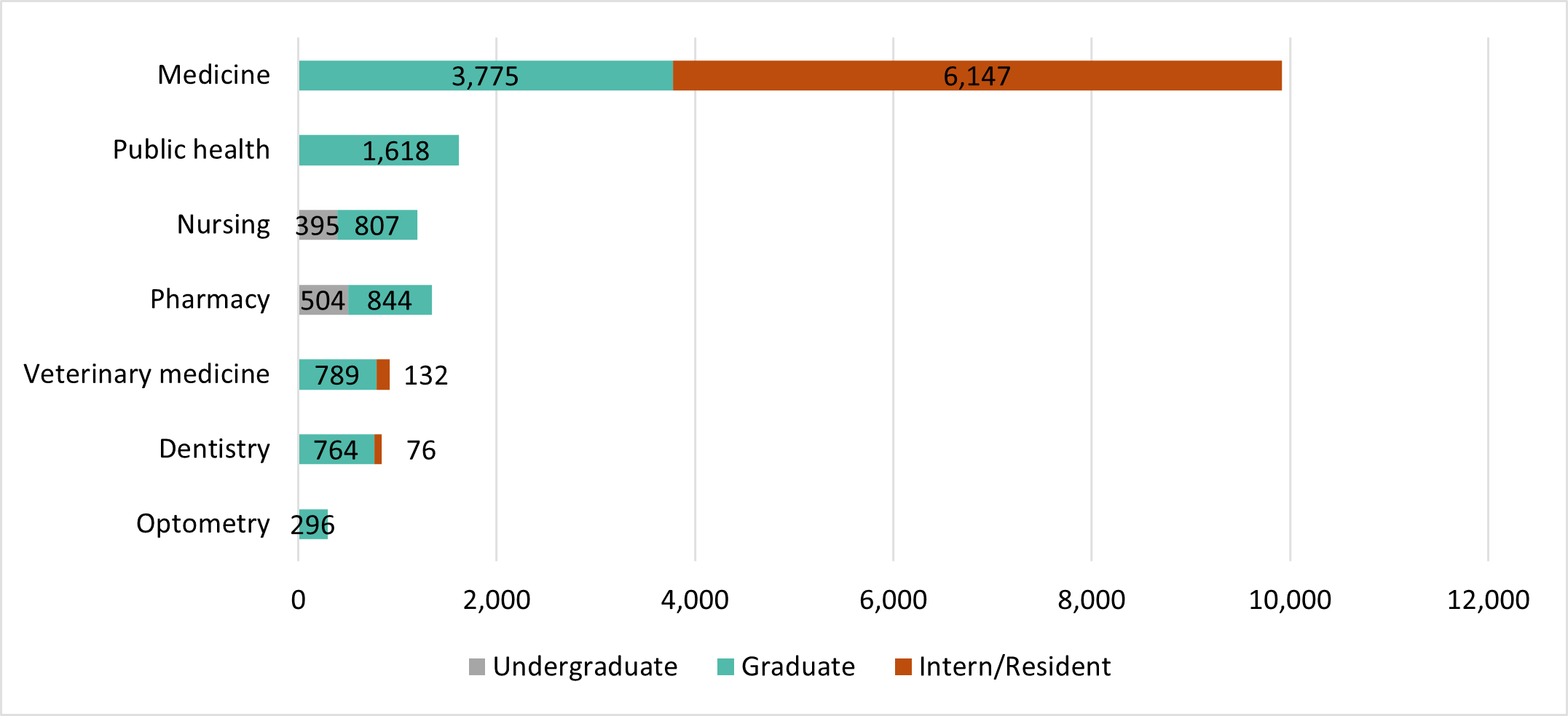
source: UC Information Center
improving california's health and well-being
University of California Health shows up every day to provide access to health care for people in our cities, rural areas and underserved communities. Our six academic health centers and 21 health professional schools deliver an unmatched level of specialty care, health professional training, innovation, and service – all rooted in academic health care, teaching and research.
UC’s health professional education and training programs are a vital source of the state’s health care ecosystem, producing future dentists, nurses, optometrists, pharmacists, physicians, public health professionals and veterinarians. The University has one of the most comprehensive and largest health professional training systems in the nation.
The University’s health training programs are deeply connected with its academic health centers, which deliver expert care to California communities, especially its most in-need. In fiscal year 2023 alone, UC academic health centers provided $1.3 billion in hospital care to Medi-Cal enrollees for which it was not reimbursed. UC’s academic health centers provided an additional $2.4 billion in uncompensated care for people with Medicare coverage in fiscal year 2023. UC faculty practice groups also supported patient care by delivering $881 million in uncompensated professional service fees for Medi-Cal and Medicare enrollees as well as direct patient financial assistance in fiscal year 2023.
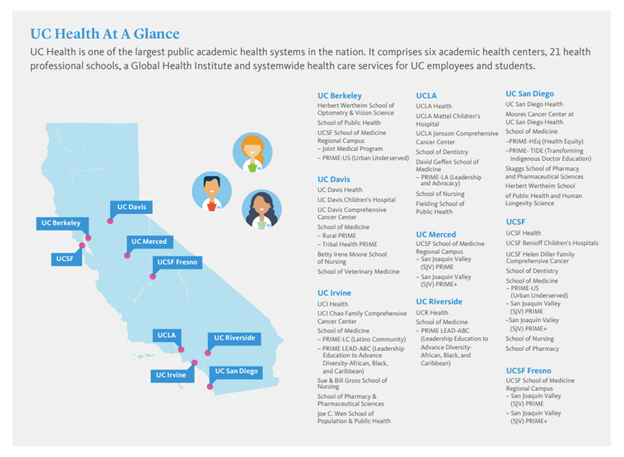
11.1 HEALTH professional Students
The University of California educates and trains more than 16,000 health care professionals annually.
11.1.1 Health professional students by discipline, fall 2024

source: UC Information Center
11.1 HEALTH professional STUDENTS
UC-trained health care professionals practice throughout the State, contributing to California having the highest physician retention rate in the nation.
11.1.2 Location of 28,799 physicians, nurses, optometrists, dentists, veterinarians, and UC medical residents trained by UC since 1999 and currently licensed in California, 2023
source: UC corporate student system and the CA Department of Consumer Affairs, as of 2023
UC Health professional school programs are a significant resource for training new health care professionals to serve across the state.
Seventy percent of UC medical school graduates go on to practice as licensed physicians in California, contributing to California having the highest physician retention rate in the nation. Data from the Association of American Medical Colleges shows that 78.5 percent of residents who completed their training in California from 2014 through 2023 are practicing in the state.
UC-sponsored residency and affiliated family medicine programs provide close to forty percent of residency training positions in the state. In 2025, forty percent of UC medical students will go on to continue their residencies at UC locations.
UC’s health professional school training programs are critical to expanding access to health care services for communities across the state.
11.2 health professsional student debt
Inflation-adjusted health professional degree fees have remained steady or declined for most programs.
11.2.1 Average total charges for health professional degree students, Universitywide, 2010–11 to 2023–24
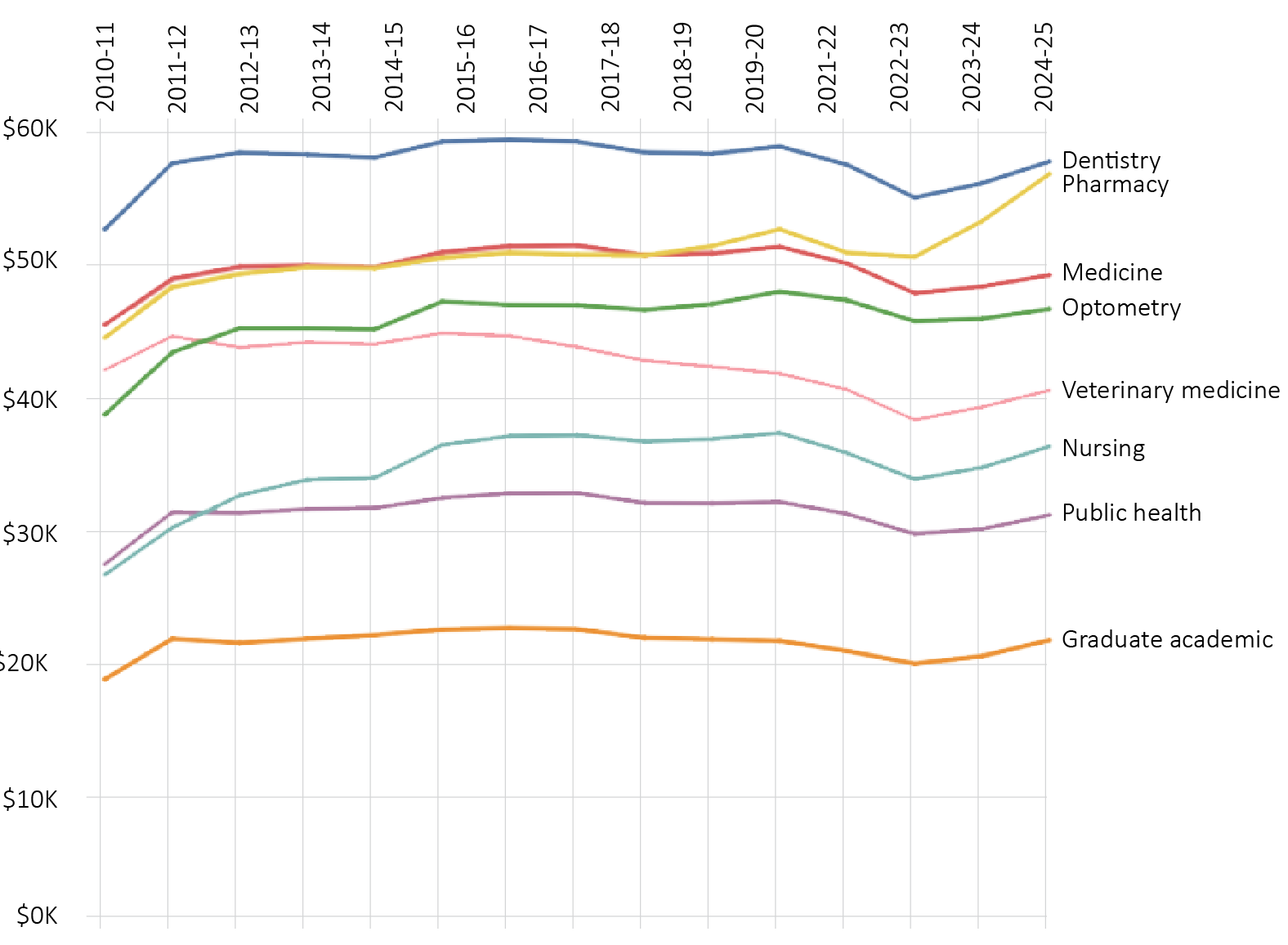
source: UC Budget Analysis and Planning
11.2 health professional student debt
Average health professional degree student debt levels are relatively flat or decreasing.
11.2.2 Health professional degree student debt at graduation, Universitywide, 2015–16 to 2023–24, selected years
![]()
Graduate student financial support and debt at graduation dashboard
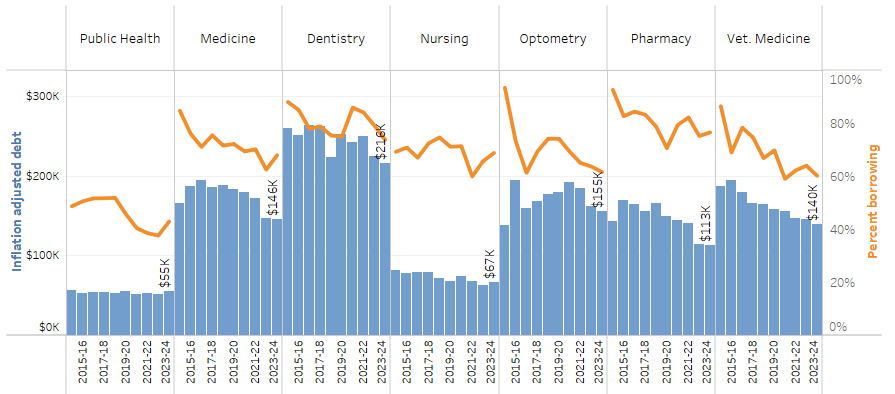
source: UC Information Center Data Warehouse
As academic health centers and safety net hospitals, UC locations are a critical part of the state's health care ecosystem.
11.3.1 Patient complexity (Case Mix Index), patient days, outpatient visits, and hospital admissions, UC medical centers
![]()
University of California Medical Centers 2023–24 Annual financial report
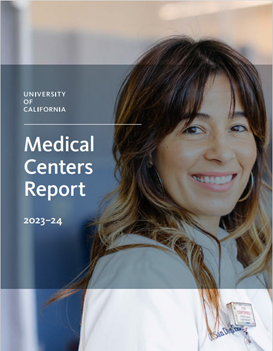
The Medical center operating statistics are described in more detail on pages 25–29 of the University of California Medical Centers 2023–24 Annual Financial Report.
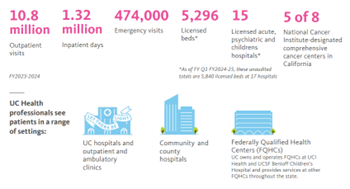
UC academic health centers care for patients’ everyday health needs, as well as those with the most complex cases. UC’s health locations provide health care services and capabilities that cannot be found at other health care providers in the state or are very limited in availability, like cancer, burn, transplant and trauma care. UC Davis Health, UCI Health, UCLA Health, UC San Diego Health and UCSF Health own and operate hospitals. UCR Health provides clinical care through community facilities, along with owned and operated clinics.
UC Health served patients from 99 percent of California’s zip codes in FY 2024-25.
11.3.2 Distribution of California zip codes served by UC Health
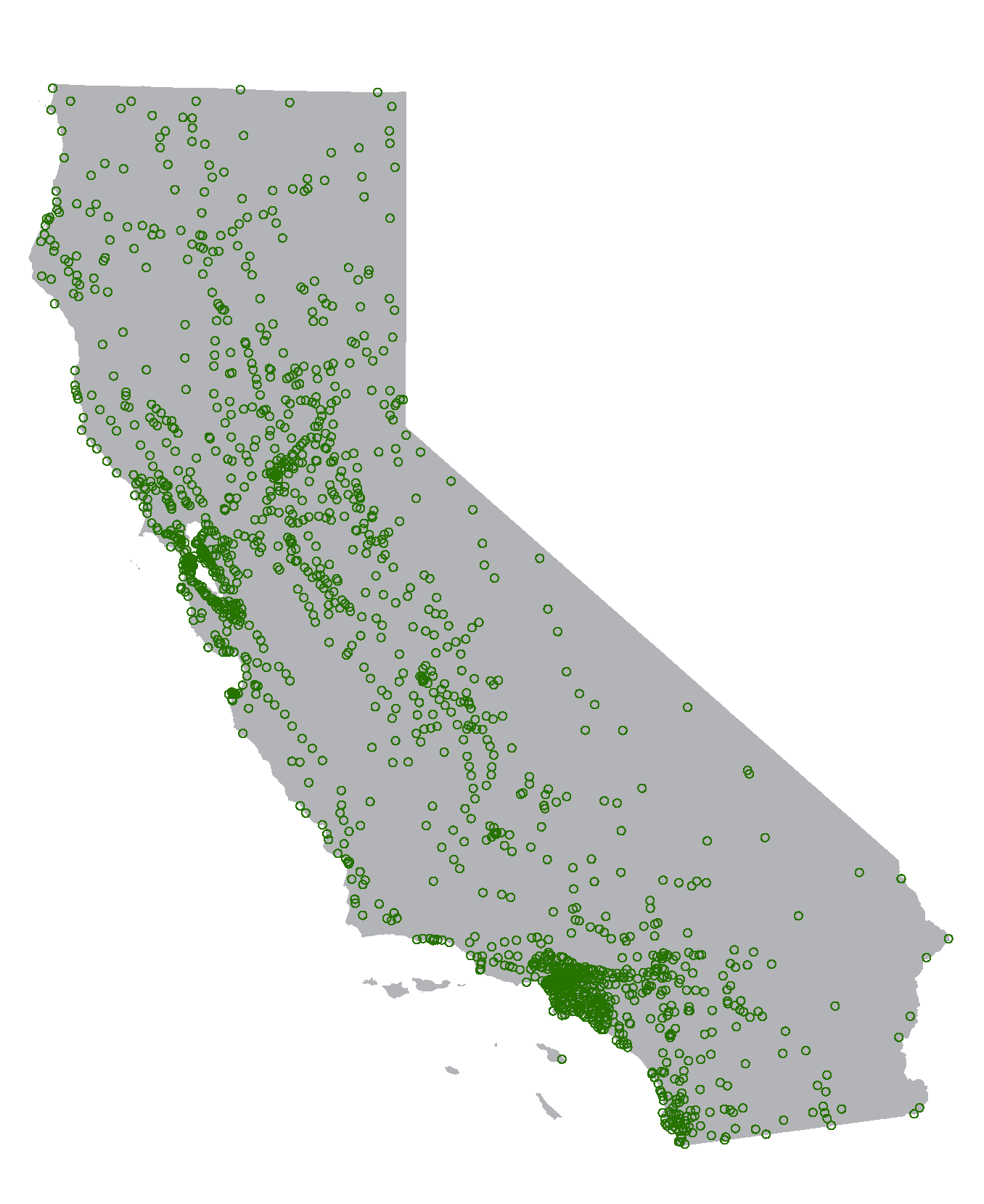
source: CDI2 UC Health Data Warehouse
UC’s academic health centers play a significant role in caring for people who come from across California.
11.4 service to medi-cal members
Approximately 1/3 of UC’s hospital beds are in service to Medi-Cal members every day.
11.4.1 Inpatient days by patient type, 2023–24
![]()
Budget for Current Operations report – page 106
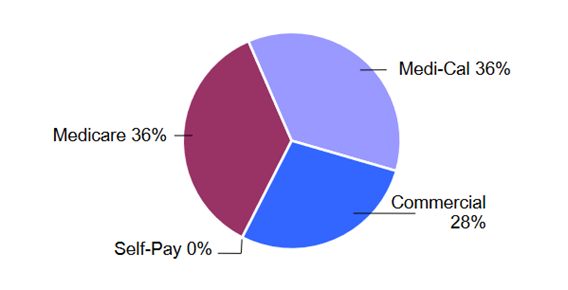
source: UC Budget for Current Operations
Note: Inpatient days associated with UCSF include UCSF Benioff Children’s Hospital Oakland,a blended component unit of the University of California.
UC academic health centers and clinics are an essential part of California’s health care safety net system. As designated public hospitals, UC’s academic health centers provide high-quality care to those in need regardless of their insurance status or ability to pay.
UC’s health care professionals also deliver primary and specialty care to lower-income Californians beyond the University’s medical centers and clinics. UC’s health locations have established partnerships to expand patient care services into local communities and make UC’s world-class health professionals more accessible for Medi-Cal members. In addition to providing care at UC-owned locations, UC health professionals deliver services to Medi-Cal members at partner county hospitals, community hospitals and Federally Qualified Health Centers (FQHCs).
11.4 service to medi-cal members
UC’s health locations have to be financially self-supporting and receive reimbursements from a mix of payors for care provided to patients.
11.4.2 Sources of reimbursements for care delivered by payor type
![]()
Budget for Current Operations report – page 107

source: UC Budget for Current Operations
Note: Financial statements associated with UCSF include UCSF Benioff Children’s Hospital Oakland, a blended component unit of the University of California.
UC Health’s not-for-profit academic health centers must generate their revenues through reimbursement for care delivered. These funds cover the costs of clinical operations, provide financial support to UC academic programs and subsidize uncompensated care for Medi-Cal and Medicare members and Californians who are in need and underinsured.
University of California Health Community Benefits Report FY 2023 (pdf)
UC Budget for Current Operations (website) includes:
Medical Centers Annual Financial Report (website) includes:
University of California Health (website)
More UCH reports and resources (website)
UC-trained health professionals in California dashboardDownload data tables for chapter 11 indicators (Excel format)